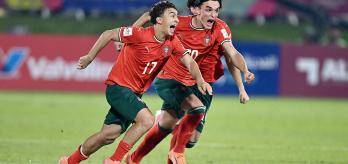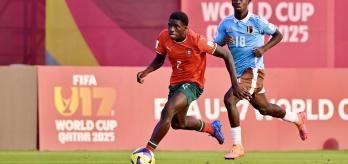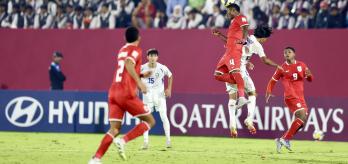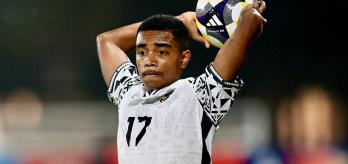During FIFA U-17 World Cup Qatar 2025™, some interesting developments in goalkeeper distribution have been observed by our Technical Study Group (TSG), and in this article, former goalkeeper and FIFA Senior Football Expert Pascal Zuberbühler discusses some of those technical and tactical nuances.
Key take-aways
-
Increase in the number of goal kicks being taken by outfield players
-
Significant increase in goal kicks being taken short
-
Greater game awareness shown by goalkeepers in their pass-selection decisions
Short goal kicks taken by outfielders
Compared to the FIFA U-17 World Cup 2023™, there has been a significant rise of 12% in the number of goal kicks being taken by outfielders. In addition, the volume of goal kicks taken short has increased from 17% in 2023 to 39% in 2025. In 2023, goal kicks were taken short, medium or long. However, in Qatar, it is a regular occurrence to see the players on either side of the goalkeeper making the first pass to the keeper, especially when facing an aggressive high press. When the goalkeeper receives that pass, most of their passes go long (54%) or medium length (34%).
Key considerations for goalkeepers
As Zuberbuhler explains, “The intelligence of the goalkeepers is important, as they need to factor in the feeling of the game and the game state when deciding what pass to make. Often, goalkeepers and centre-backs make the most passes, and because the goalkeepers are becoming more like playmakers, their ability to read the situation and decide the best passing option is vital.”
-
Is the target player strong in the air?
-
Does the target player have a favourable match-up?
-
Which foot is their strongest?
-
From where will the receiver encounter pressure?
-
Do they like running into space?
-
Are they strong at receiving with their back to goal and protecting the ball to bring others into play?
“It’s not enough to see a free player and just play to them; goalkeepers must read the options available to that player and understand the type of delivery that will best facilitate the receiver’s next action in relation to the pressure they might experience. The goalkeeper must know the key strengths of their team-mates and be positioned the required distance from the ball to deliver the desired pass. Also, it's important for outfield players to know the strengths of their goalkeeper and the type of distributions he can make.”
Medium pass after receiving from an outfielder
In clip 1 below, Zuberbühler highlights the outstanding technique, composure and game awareness displayed by Czechia goalkeeper Adam Paar (21) as he accepts the direct pressure before creating an angle to break the first line of the USA’s high press.
“The angle of the pressure denies him the option of playing a medium or long pass, but he sees the offer to receive from his centre-midfielder and confidently creates the space to play the pass. This pass draws the USA’s right forward inside to the receiver, leaving Czechia left-back Lukas Vanek (8) free. Centre-back Sebastian Pech (13) receives the ball and finds him, and Czechia break USA’s aggressive press.”
Long pass after receiving from an outfielder
With 76 minutes played and leading 2-0, England goalkeeper Jack Porter (1) receives a short pass from his left-sided centre-back, allowing him to take a safe first touch, which tees up the stride distance he needs to deliver a high-quality long pass into his centre-forward. He strikes it with his laces, placing it perfectly on the chest of the centre-forward, who receives with his back to goal with support available underneath to receive and progress the ball.
In clip 3, Zuberbühler notes an outstanding and instinctive example of a goalkeeper using their own intuition.
“Austria’s left centre-back plays short to goalkeeper Daniel Posch (21). As he takes his first touches, he sees there are no real options for him to play the ball to his defenders or midfielders. He recognises that his two highest players are in 1v1 situations in both wide areas and, at first, feints to kick long. Forward player Dominik Dobis (11), positioned on the left, sees the opportunity and makes a diagonal run from out to in. This is spotted by Posch, and he plays an inch-perfect long, forward pass which lands in the central channel, favouring the attacking run. Dobis is fouled and a penalty is awarded. Was the feint to kick long a trigger for the run? This is an intelligent and decisive distribution from the goalkeeper.”
Long, direct goal kick
During this U-17 World Cup, teams used different methods to initiate attacks. In goal-kick situations, goalkeepers are responsible for recognising where the key attacking opportunity exists and having the capacity to alter their team’s game by varying their distribution. In Qatar, we have seen this trend continue, with relative consistencies in goal kicks being taken short, medium range or long, with the highest volume of goal kicks taken by goalkeepers going long (45%).
In clip 4, Zuberbuhler highlights an example of the Republic of Ireland’s use of a long pass from their goalkeeper to initiate an efficient attack.
“Their intention is clear, and they want to compete for the ball higher up the pitch and play from there. Near the beginning of the game, it was 0-0, and it was clear that left winger Jaden Umeh (11) was strong in the air. We can also see how centre-forward Michael Noonan (9) is ready for the flick-on and is aware of the anticipatory support runs being made outside him by midfielders Max Kovaleski (17) and Grady McDonnell (7).
The playmaker
When our TSG observed how Venezuela orchestrated their build-up against a low block, the role of their goalkeeper, Angel Pérez (12), piqued their interest. While the clip below is from their match against Haiti, this was an approach they applied in other games, also.
As can be seen, Pérez advances high, building in a three with his two centre-backs. Many teams build possession in a three, but by including their goalkeeper in this way, Venezuela could push an additional player into a higher position.
Is this a new evolution in build-up from the goalkeeper?















